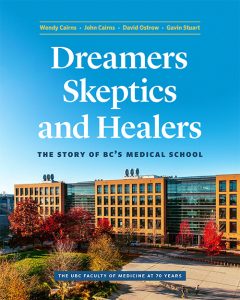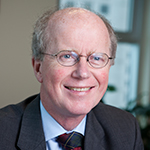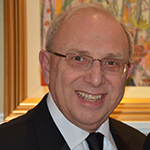A conversation with authors Drs. John Cairns, David Ostrow and Gavin Stuart.

Since UBC’s Faculty of Medicine opened its doors to its first 60 medical students in 1950, it’s grown to become a global leader in medical education and health sciences research and home to one of the top-ranked medical schools in the world.
But the creation of the Faculty of Medicine was threatened from the start.
In the new book Dreamers, Skeptics and Healers, authors John and Wendy Cairns, David Ostrow and Gavin Stuart tell the remarkable journey of the Faculty of Medicine’s first 70 years, tracing its trials, tribulations, and triumphs, and celebrating the many visionaries, leaders, faculty and students who paved the way for its success.
We spoke with the authors about the inspiration for their book, what they learned about the Faculty of Medicine along the way, and their predictions for the next 70 years.
What was the inspiration for writing this book?

Wendy Cairns
JC: Back in the late 1990s, shortly after I became Dean of the Faculty of Medicine, my wife Wendy Cairns came up with the idea of writing the Faculty’s story of adversity and ultimate success. Over the years, she accumulated boxes of materials from UBC’s rich archives and gathered materials and recollections from influential people who had played a role in the Faculty’s first fifty years.
When Wendy passed away in 2018, Gavin Stuart, who succeeded me as Dean, and David Ostrow, UBC emeritus professor of respiratory medicine and the former CEO of Vancouver Coastal Health Authority, joined me in bringing the story to fruition.
It’s been a tremendous journey.
What’s behind the title, Dreamers, Skeptics and Healers?

Gavin Stuart
GS: The title reflects the fact that our book tells the story of the Faculty’s key players: the visionaries who dreamt about the creation of a medical school in B.C, the skeptics who resisted or had their doubts, and the many graduates of the school who have gone on to care for and improve the lives of patients and our communities.
The tagline of the book—The Story of B.C.’s Medical School—is equally important and reflects the fact this is not a history of UBC Vancouver, but a story about the entire province. From its earliest days, there was a province-wide vision for the medical school. This vision was nurtured and ultimately led to the innovative and distributed model medical education that we have today, with learners training in every corner of the province. By making real connections with B.C.’s diverse communities, UBC graduates are inspired to settle where they train, improving access to care and health for patients and families.
While researching and writing this book, what surprised you, or what did you discover about the Faculty that you didn’t already know?

John Cairns
JC: For me, it was quite a revelation to learn about the early origins of the Faculty and some of the visionary players, like Claude E. Dolman.
Dolman was a bright young microbiologist, who had been an assistant in Alexander Fleming’s laboratory at St. Mary’s Hospital Medical School, London, when the discovery of penicillin was made. After immigrating to Canada and moving to Vancouver in 1935 to take on the role of Head of UBC Department of Bacteriology and Preventive Medicine, Dolman began drafting plans for the initial years of a new medical school—an initiative that would lead him to become a central player in the controversial beginnings of UBC’s Faculty of Medicine.
What is your favorite page in the book?

David Ostrow
DO: My favorite page is 162, which shows a map of the Faculty of Medicine’s network of education and training sites across B.C., and demonstrates just how embedded this school is in the province. With more than 80 training sites, ranging from Abbotsford to Armstrong and Parkville to Prince Rupert, UBC truly has a province-wide program—which was also first of its kind in Canada.
GS: For me, it’s page 168, with the picture of entrance sign to the Port McNeill & District Hospital on Vancouver Island. The sign proudly displays UBC Faculty of Medicine’s logo, indicating not only the presence, but the contribution of our learners and faculty.
JC: I love the historical images on page xviii of what the UBC campus looked like in 1927, and comparing it to later images of the medical school in 1950 and the Life Sciences Institute, which opened in 2004. It’s really amazing to see where we came from, and where we are now.
What do you think the next 70 years could hold? What’s next in healthcare?
GS: Looking ahead, I think healthcare delivery will become much more population-focused. The COVID-19 pandemic has been an enormous wake up, and I think we will be putting much more focus on the health of populations and the social determinants of health moving forward.
Learn more and order a copy of Dreamers, Skeptics and Healers here.